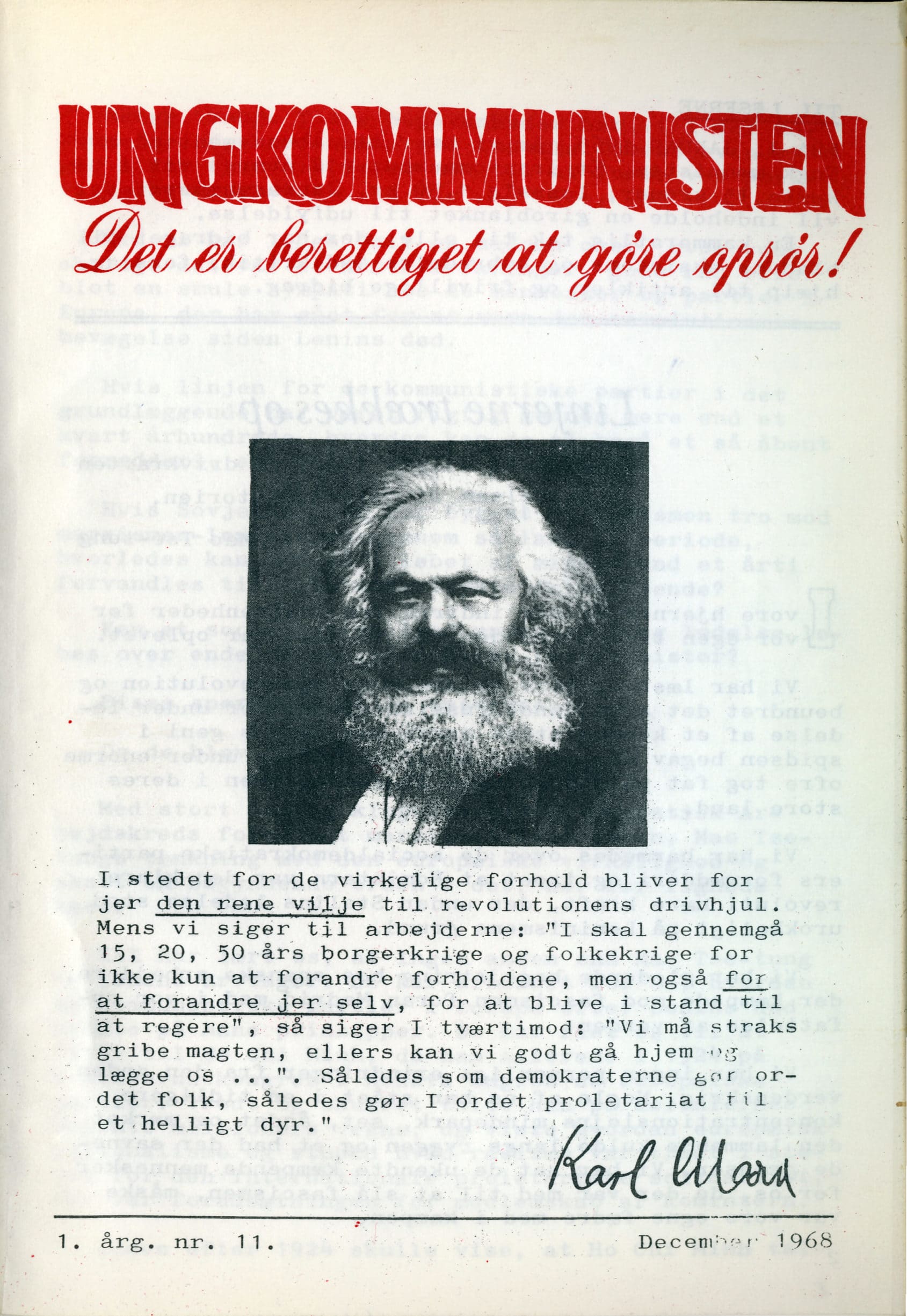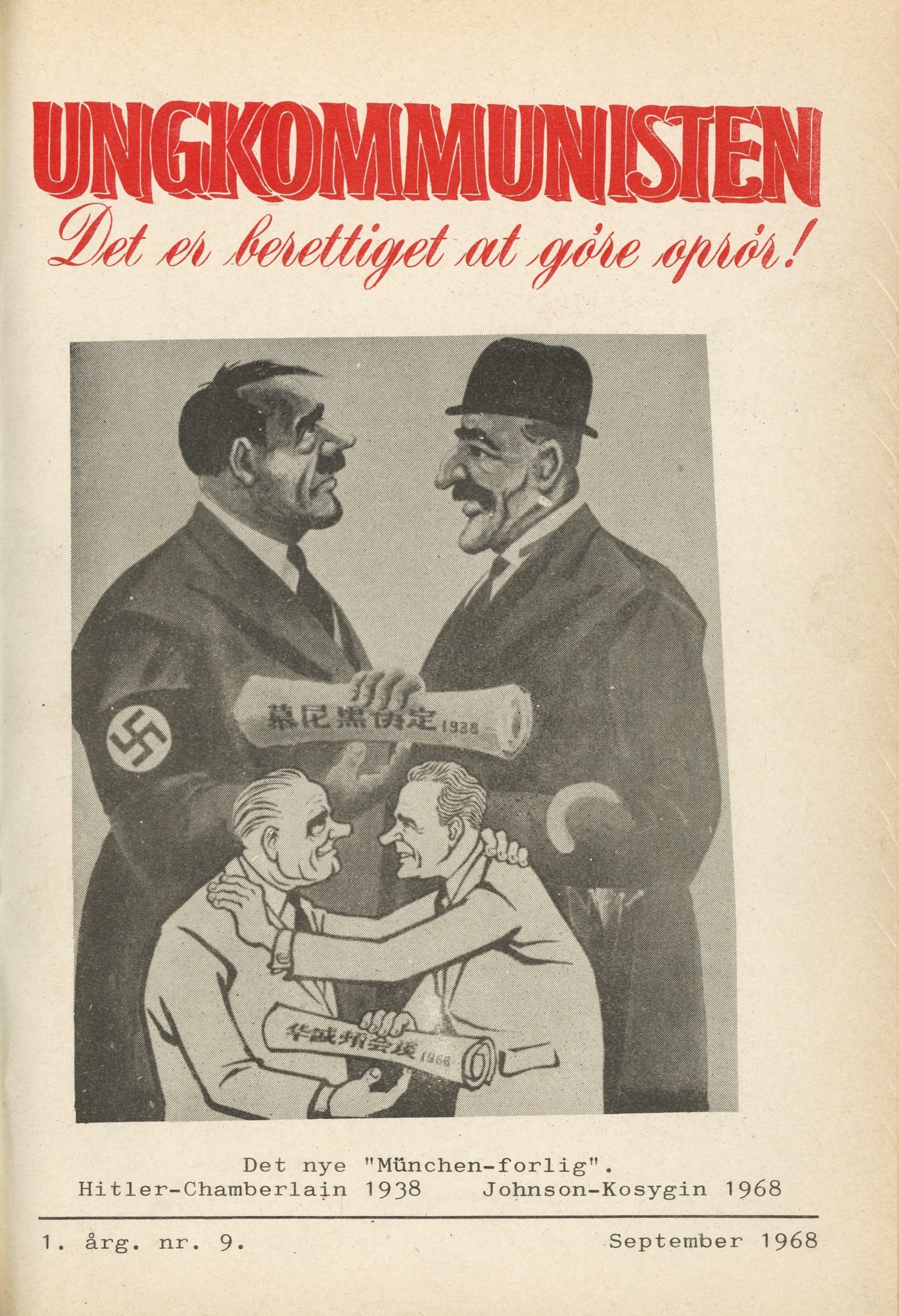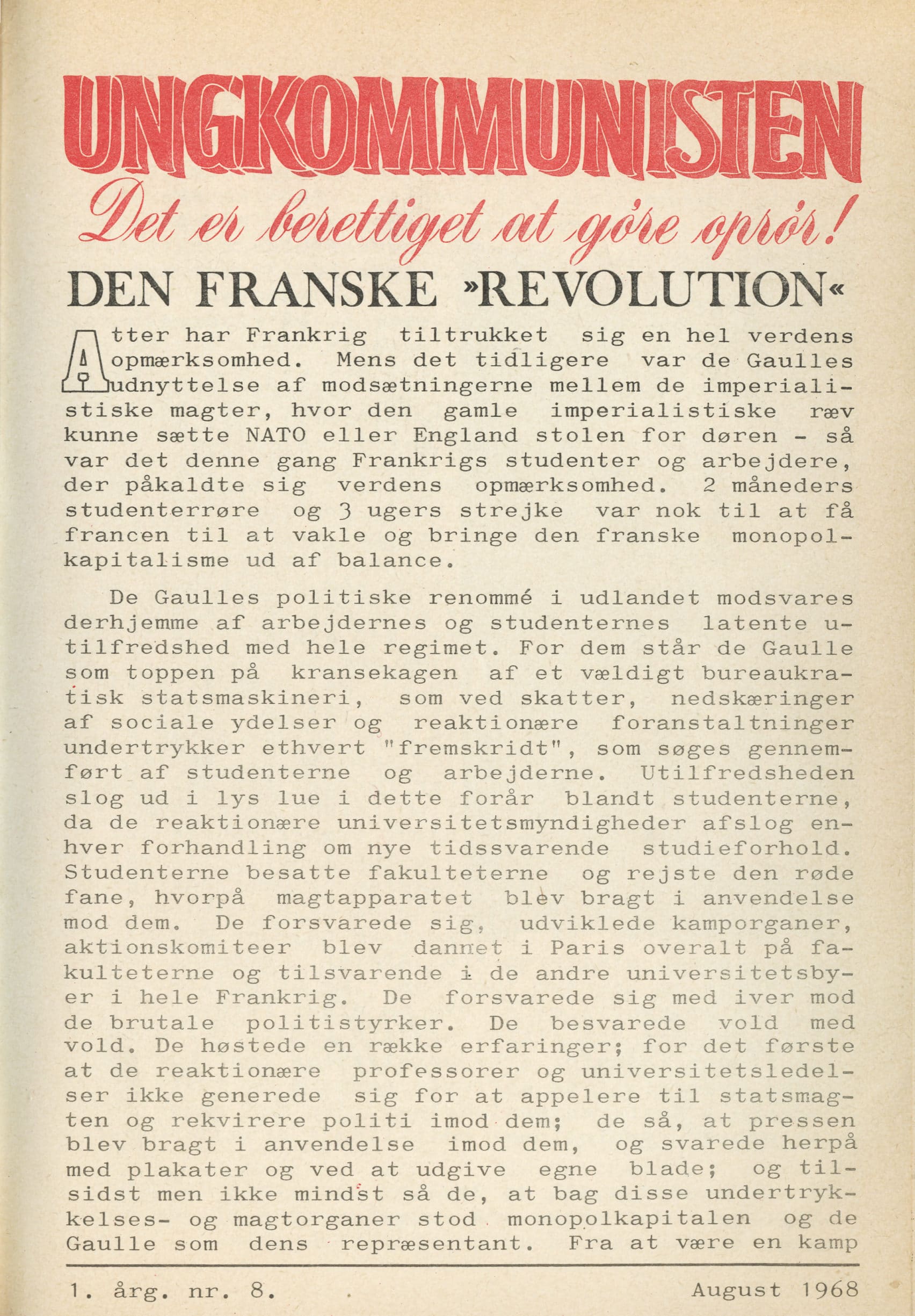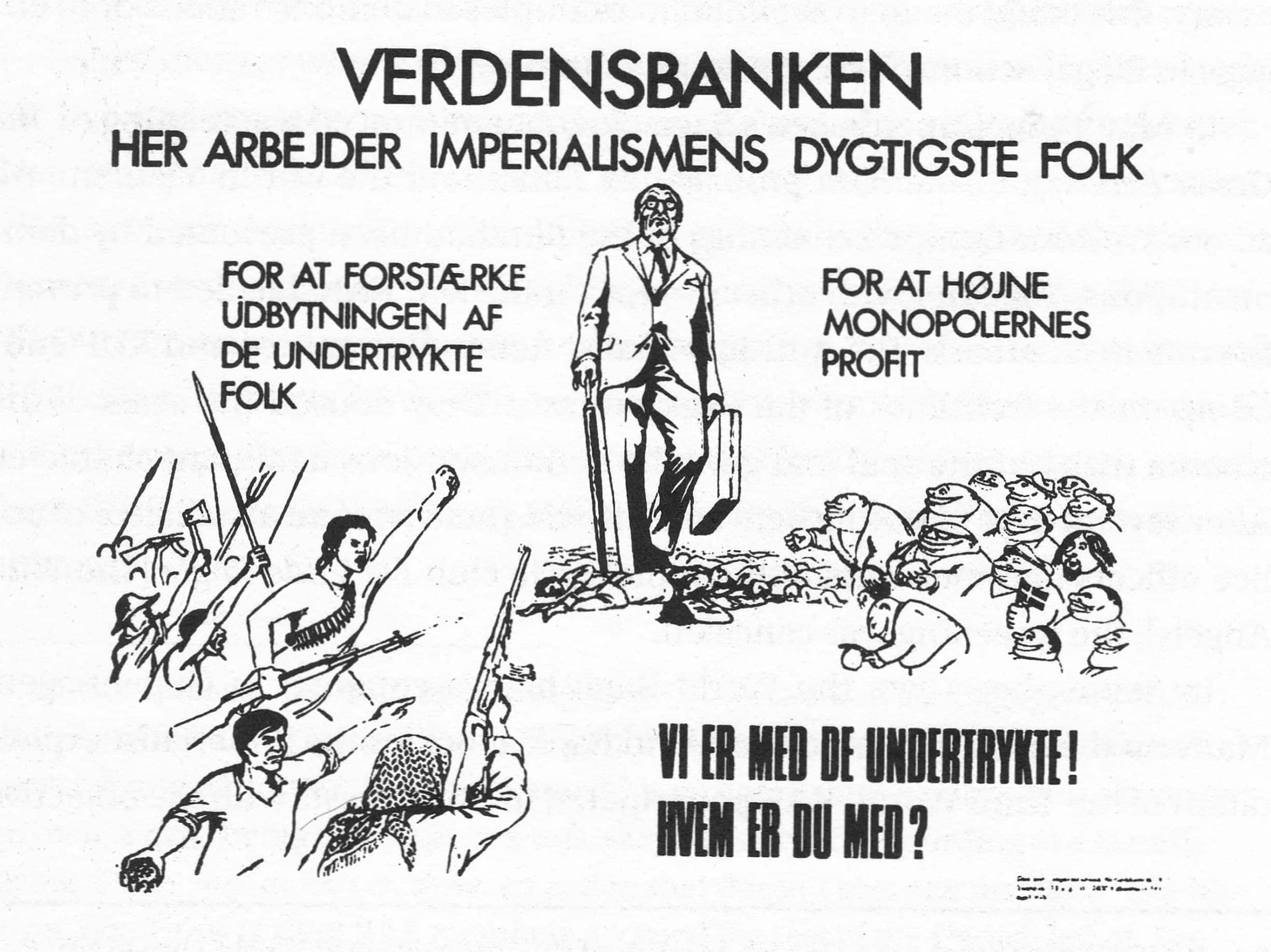The Development of Capitalism in the Nineteenth Century
The first tendencies towards a division of the world into a rich imperialist part and a poor exploited part can be seen in the second half of the nineteenth century. As early as at that time it seemed as if the capitalist mode of production was about to be played out as a progressive force. The capitalist world was shaken by ever more serious economic crises at ever shorter intervals. The social consequences of those crises made the spectre of Communism haunt Europe.
However, imperialism and the consequential division of the world into rich and poor countries (classes) offered new conditions of growth for capitalism. The crisis was overcome and capitalism developed as never before. The spectre of Communism was exorcised. Marx’s and Engels’ ideas about the potentialities of capitalism were turned upside down by this. Below we shall discuss in detail the contradictions which led to the capitalist crises – and what resolved them around the turn of the century.
Britain’s Industrial Monopoly
The external precondition of Britain’s growth as a capitalist country was a commercial empire which resulted in the foundation of a world-wide colonial empire. Britain became the centre of world trade, and an industrial division of labour developed in relation to overseas countries. They supplied the raw material to British industry which in return supplied the finished products. Britain became the workshop of the world, and her industry expanded in an international vacuum created by the British navy. Thus the monopoly of the international market gave Britain a similar monopoly of industrial manufacture, a monopoly which Britain held during the first half of the nineteenth century.[1]
During this initial period British capitalism developed at the expense of handicraft nationally as well as internationally, which meant that British industrial goods were comparatively cheaper – British industry was able to sell all the goods that it could produce.
The Contradiction Production – Consumption
Already in the 1840s capitalist Britain was marked by crises. These appeared as overproduction, which was a result of the contradiction production-consumption. This contradiction characterizes the capitalist mode of production. The capitalists produce only to increase their capital. In order to achieve the highest rate of profit possible the capitalists will always be forced to increase production, to introduce new technology and to throw an ever increasing number of articles into the market.
But the extent of the population’s consumption is limited by the laws set by capitalist exploitation. On the one hand the capitalists fight to keep wages as low as possible to achieve the highest rate of profit possible. On the other hand wages represent a considerable part of the demand which is to yield the profit when the goods are sold.
Thus the capitalist mode of accumulation tends to ruin its own market. If the capitalists increase the wages, they will limit their own potential profit – and if the wages are lowered, the market will be limited. In both cases the capitalists will cease making investments. In the first case they will not have the capability, and in the second they will lack the incentive of a market able to buy. About this Engels writes:
We have seen that the ever-increasing perfectibility of modern machinery is, by the anarchy of social production, turned into a compulsory law that forces the individual capitalist always to improve his machinery, always to increase its productive force. The bare possibility of extending the field of production is transformed for him into a similar compulsory law. The enormous expansive force of modern industry, compared with which that of the gases is mere child’s play, appears to us now as a necessity for expansion, both qualitative and quantitative, that laughs at all resistance. Such resistance is offered by consumption, by sales, by the markets for the productive modern industry. But the capacity for extension, extensive and intensive, of the markets is primarily governed by quite different laws that work much less energetically. The extension of the markets cannot keep pace with the extension of production. The collision becomes inevitable, and as this cannot produce any real solution so long as it does not break in pieces the capitalist mode of production, the collisions becomes periodic….
Capitalist production has begotten another “vicious circle”. (Engels, Socialism, MESW, p. 419.)
Marx & Engels On the Potentialities of Capitalism
As early as in the 1840s Britain was marked by such crises of overproduction. On the one hand the rapid accumulation in the first decades of the century meant an enormous increase in the capacity of the production apparatus. On the other hand the low wages meant a reduction of the domestic market. Internationally, French and American industry began to be competitive. Industry no longer competed with handicraft only. The competition among the capitalists themselves became the most important.
This initial period of the development of industrial capitalism resulted in a revolution of the productive forces and an enormous increase in productivity. The advance from spinning-wheel to spinning-machine, from hand-loom to power-loom, the invention of the steam engine, the introduction of the railways… increased productivity enormously. However, this increase in productivity did not in any way mean better conditions for the working class – on the contrary. During the whole period wages were near the physiological subsistence level.[2]
The contradiction between the still increasing production and the stagnant tendency in consumption resulted in a fall in the rate of profit – in crises of overproduction. Capitalism had only one way in which these crises could be avoided, and that was to find new markets for their goods and capital. Capitalism cannot be confined to one country; according to its very nature it must continuously expand. The Manifesto of the Communist Party says:
The need of a constantly expanding market for its products chases the bourgeoisie over the whole surface of the globe. It must nestle everywhere, settle everywhere, establish connexions everywhere….
The bourgeoisie, by the rapid improvement of all instruments of production, by the immensely facilitated means of communications, draws all, even the most barbarian, nations into civilisation. The cheap prices of its commodities are the heavy artillery with which it batters down all Chinese walls, with which it forces the barbarians’ intensely obstinate hatred of foreigners to capitulate. It compels all nations, on pain of extinction, to adopt the bourgeois mode of production; it compels them to introduce what it calls civilisation into their midst, i.e., to become bourgeois themselves. In one word, it creates a world after its own image. (Marx & Engels, op. cit., MESW, pp. 38-9.)
Marx also describes how British capital had to seek outside Britain to find profitable openings for investments:
The really disquieting feature for England… is this, that she is apparently at a loss to find at home a sufficient field of employment for her unwieldy capital; that she must consequently lend on an increasing scale, and similar, in this point, to Holland, Venice and Genoa, at the epoch of their decline, forge herself the weapons for her competitors. [3] She is forced, by giving large credits, to foster speculation in other countries in order to find a field of employment for her surplus capital; and thus to hazard her acquired wealth in order to augment and conserve it. By being obliged to give large credits to foreign manufacturing countries, such as the Continent of Europe, she forwards herself the means to her industrial rivals to compete with her for the raw produce, and thus is herself instrumental in enhancing the raw material of her own fabrics. The small margin of profit thus left to the British manufacturer, still reduced by the constant necessity for a country the very existence of which is bound up with the monopoly of forming the workshop of the world, constantly to undersell the rest of the world, is then compensated for by curtailing the wages of the laboring classes and creating home misery on a rapidly-enlarging scale. Such is the natural price paid by England for her commercial and industrial supremacy.
(Marx, British Commerce, MECW, v. 15, p. 430.)
Thus Marx regarded capitalist development as a centrifugal process. It was the contradictions of capitalism itself which caused this process. These contradictions were manifested by the decreasing possibilities of profitable investments in the highest developed, capitalist countries. At the same time more profitable investments could be made in the colonies and in the less developed countries. This situation led to capital exports. Marx believed that this would result in capitalism spreading all over the world. But he did not imagine that this would result in a “fixed” division of the world highly developed imperialist centre and an exploited and underdeveloped periphery. Marx thought that capital would flow out and make the rest of the world a reflected image of Britain and thus develop globally the same contradictions which threatened British capitalism.[4]
The country that is more developed industrially only shows, to the less developed, the image of its own future. (Capital, v. I, p. 19.)
Around 1830 Britain had carried through the initial stage of the industrial revolution. At that time continental Europe and the United States had hardly begun their industrial revolution. These countries did not become a periphery to Britain. On the contrary British capital contributed to a large extent to making them highly developed capitalist countries. The United States caught up with Britain a few decades later. Marx believed that the development in the colonies in Asia and Africa would be similar. When Britain had destroyed the original societies and introduced capitalism, these colonies would experience a rapid development which would make them the reflected image of Britain. About Britain’s role in India Marx says:
England has to fulfil a double mission in India, one destructive, the other regenerating – the annihilation of old Asiatic society, and the laying of the material foundations of Western society in Asia….
I know that the English millocracy intend to endow India with railways with the exclusive view of extracting at diminished expenses the cotton and other raw materials for their manufactures. But when you have once introduced machinery into the locomotion of a country, which possesses iron and coals, you are unable to withhold it from its fabrication. You cannot maintain a net of railways over an immense country without introducing all those industrial processes necessary to meet the immediate and current wants of railway locomotion, and out of which there must grow the application of machinery to those branches of industry not immediately connected with railways. The railway system will therefore become, in India, truly the forerunner of modern industry.
(Marx, Future Results, MEOC, pp. 82,84)
The opening of new markets in Africa and Asia, the capitalist exports to North and South America would put off the collapse of capitalism for a while. However, it would only be a short respite; the final result would merely be an even more intense accumulation which would lead to a new and more intensified crisis of overproduction.
Engels outlines the perspective of capitalist development in the following way:
Even in quite barbarous lands the bourgeoisie is advancing. In Russia, industry is developing by leaps and bounds and is succeeding in converting even the boyars into bourgeois. Both in Russia and Poland serfdom is being restricted and the nobility thereby weakened in the interest of the bourgeoisie, and a class of free peasants is being created which the bourgeoisie everywhere needs…. – In Hungary the feudal magnates are more and more changing into wholesale corn and wool merchants and cattle dealers, and consequently now appear in the Diet as bourgeois. – What of all the glorious advances of “civilisation” in such lands as Turkey, Egypt, Tunis, Persia, and other barbarous countries? They are nothing else but a preparation for the advent of a future bourgeoisie. In these countries the word of the prophet is being fulfilled: “Prepare ye the way of the Lord… Lift up your heads, 0 ye gates; and be ye lift up, ye everlasting doors; and the King of glory shall come in. Who is the King of glory?” – The bourgeois!
Wherever we look, the bourgeoisie are making stupendous progress. They are holding their heads high, and haughtily challenge their enemies. They expect a decisive victory, and their hopes will not be disappointed. They intend to shape the whole world according to their standard, and, on a considerable portion of the earth’s surface, they will succeed.
We are no friends of the bourgeoisie. That is common knowledge. But this time we do not grudge the bourgeoisie their triumph. We can chuckle over the haughty looks which the bourgeois deign to bestow (especially in Germany) upon the apparently tiny band of democrats and Communists. We have no objection if everywhere they force through their purposes.
Nay more. We cannot forbear an ironical smile when we observe the terrible earnestness, the pathetic enthusiasm with which the bourgeois strive to achieve their aims. They really believe that they are working on their own behalf! They are so shortsighted as to fancy that through their triumph the world will assume its final configuration. Yet nothing is more clear than that they are everywhere preparing the way for us, for the democrats and the Communists, than that they will at most win a few years of troubled enjoyment, only to be then immediately overthrown….
So just fight bravely on, most gracious masters of capital! We need you for the present; here and there we even need you as rulers. You have to clear the vestiges of the Middle Ages and of absolute monarchy out of our path; you have to annihilate patriarchalism; you have to carry out centralisation; you have to convert the more or less propertyless classes into genuine proletarians, into recruits for us, by your factories and your commercial relationships you must create for us the basis of the material means which the proletariat needs for the attainment of freedom. In recompense whereof you shall be allowed to rule for a short time. You shall be allowed to dictate your laws, to bask in the rays of the majesty you have created, to spread your banquets in the halls of kings, and to take the beautiful princess to wife – but do not forget that “The hangman stands at the door!”
The New Manifestation of the Contradiction
Marx’s and Engels’ predictions regarding the development of the colonies and the early collapse of capitalism did not come true. Not that their analyses of capitalism at that time were wrong. At the middle of the nineteenth century, the capitalist system actually was on the verge of having exhausted its potentials. The crises arose at shorter and shorter intervals and assumed an increasingly serious character. The strength and fighting spirit of the proletariat grew accordingly. What Marx and Engels could not foresee was that the very fight of the proletariat for better conditions became the incentive behind a global change of the capitalist mode of accumulation, a change which meant a postponement of the collapse of capitalism. When aggravating crises seemed to bode its collapse, a development started which offered renewed growing power and life to capitalism, but based on transfer of values from abroad.
From the middle of the nineteenth century the conditions of the European proletariat began to change. For the first time in the history of capitalism, the capitalists had to pay wages above the mere subsistence level. This first tiny improvement was not primarily a result of the fight of the proletariat itself. The labour movement was politically weaker than before and Chartism had been impaired by cleavage and corruption.[5] These first improvements in wages and working conditions for the British proletariat were due to contradictions between the ruling classes.
As mentioned above, Britain had a virtual monopoly of industrial goods at the beginning of the nineteenth century. This monopoly resulted in extra profits. However, this profit did not primarily go to the industrial capitalists, and during the first part of the century it definitely did not result in higher real wages to the working class either. Paradoxically, the extra profits froth the industrial monopoly had mainly gone to the class of landowners.
By virtue of their historically strong position in Parliament, the landowners had succeeded in introducing an embargo on the importation of corn and other agricultural products into Britain from 1804. This embargo meant that the landowners could maintain an artificially high level of prices for their products. The high prices meant that the capitalists had to pay the workers comparatively high nominal wages just to enable them to live above the breadline. However, wages were still subsistence wages, and no increase in real wages could be seen.
By this artificially high price of corn the landowners could secure a considerable part of the extra profits earned by the British industrial monopoly. So in the 1840s the industrial capitalists urged to have the Corn Laws repealed. Together with the working class they succeeded in repealing the laws in 1846. And the reopening of the importation of corn from Prussia especially and later from the United States did cause a fall in prices of bread and other food.

Following the fall in corn prices, the industrial capitalists tried to decrease the nominal wages, but the working class was able to limit the decrease and thus to obtain an improvement in real wages. This tendency was further enhanced by the introduction of a ten-hour working-day, which the working class had been fighting for for 30 years. It was introduced shortly after the abrogation of the Corn Laws as the working class was unexpectedly supported by the landowners in Parliament, who thirsted for revenge on the industrial capitalists.
The extra profits of the British industrial monopoly and the internal fight between landowners and industrial capitalists thus meant that the wages of the British Working class were increased above the subsistence level at which they had so far been kept.
Towards the end of the century this tendency was further reinforced – now as a direct result of the struggle of the working class. The working class organized itself in powerful unions and became integrated into the bourgeois parliamentary democracy. Parts of the class succeeded in obtaining improved wages and working conditions and extended political and industrial rights. This increase in wages – which occurred first in Britain, later in France, Germany and the other West European countries – contributed to resolving the profound crises which capitalism experienced in the 1870s and 1880s in Europe. For the wage increases meant an expansion of the domestic market, growing market potentials and a solution to the crises of overproduction. This wage increase and the consequent market expansion took place without the rate of profit falling below the acceptable line for capital accumulation. The historical background to this was first the incorporation, i.e. the proletarization and exploitation, of an increasing number of people of the colonial areas into the capitalist system. Not only as markets for industrial products as had been the case before, but now to an increasing extent as labourers or workers in plantations, mines, and factories run by capitalists. But here wages were at a physical minimum – or below. This ruthless exploitation of colonial labour was the basis of bigger profits in the colonies compared with those “at home”. Then the movement of capital within the individual colonial power and its colonies could gradually result in a tendency towards an equalization of the rate of profit. Money invested at home and money invested in the colonies yielded profits according to the amount of capital invested. The rate of profit did not depend on where the capital was invested or how much surplus labour it actually extorted from the workers. The fall in the rate of profit which could be expected as a result of the rising wages in Europe was equalized by the increase in surplus labour in the colonies. Surplus labour – extorted from the proletariat in the colonies – compensated for the fall in the rate of profit in the “mother countries”. The compensation was seen by a tendency to an equalization of the rate of profit.
Globally, this was the beginning of a temporary solution to the contradiction production-consumption. On the one hand the capitalists took advantage of the increasing wages “at home” and the consequential improvement of the demand. On the other hand the low wages in colonial areas secured a high rate of profit.
The result was a gradual change of the capital flow within the global capitalist system. Instead of exporting capital, the highly developed capitalist countries – i.e. the imperialist countries – began to absorb capital from the colonies. Earlier, Capital had tried to modify its tendencies towards crises by exporting surplus capital, but now things began to change. The imperialist countries could now – as a consequence of the expanding domestic market – find investments at home for their capital. Actually, there was not capital enough. Capital started to flow from the colonies to the imperialist countries. It is true that British capital exports increased strongly towards the end of the nineteenth century, but capital imports – the repatriation of profits – increased together with exports, so there was no question at all of capital exports in its proper sense. Therefore, during this epoch of classic imperialism British capital exports do not reflect a situation in which surplus capital in the domestic market cannot find profitable openings for investments.[6] Where capitalism had earlier tended to equalize the difference, in development between the highly developed industrialized countries and the colonies by means of net capital exports, a development now began which divided the world into developed and underdeveloped – into rich and poor countries. This division of the world became a historical necessity for continued expansion of the capitalist mode of production, and formed the basis of a new epoch in capitalist development. It created a framework which resulted in capitalism being able to develop the productive forces at renewed speed.
We would like to stress that this development or tendency starts at the end of the nineteenth century. At first, the improvements in wages and working conditions did not radically change the material conditions of the British working class. The increase in wages by no means applied to the entire class; they were confined to the skilled and better organized part of the industrial workers. Compared with today’s standard of living in Europe even these workers’ conditions were wretched. But compared to the general conditions during the first half of the century – and compared to the labourers and slaves in the colonies – improvements in wages, working conditions and political rights had certainly taken place. At the beginning of our century, widespread hunger and distress – as it can be seen in the Third World today – had disappeared in Britain and the other West European countries.
Generally speaking, the conditions of the working class have improved in these countries since at the end of the nineteenth century. Setbacks and crises have occurred, but they have been resolved within the framework of the system – and the solutions have led to a consolidation of the capitalist system in the rich countries.
Politically the new economic tendency immediately became of greater importance as it changed the conditions of the class struggle. The economic and political improvements which the capitalist class would not at any price grant during the first half of the century – and could not possibly grant at that time – it began to concede at the end of the century. But absolutely not voluntarily. The working class in Europe and in the United States won their economic and political improvements through hard industrial and political fights with the bourgeoisie. Earlier improvements of working class conditions questioned the very existence of capitalism. Now it became possible to obtain considerable improvements within the capitalist framework, because these improvements were paid for by the exploitation of the population in the colonies.
The difference in wages of the workers in the colonies and in the imperialist countries resulted in cheaper and cheaper products from the colonies, while products from the imperialist countries became increasingly expensive. In this way a new mode of imperialist exploitation arose: Unequal exchange – the exploitation of the poor countries through trade with the rich countries. The economic importance of unequal exchange has grown pari passu with the differences in wages between rich and poor countries. This method of exploitation becomes prevalent after the Second World War as a consequence of the very substantial wage increases in Western Europe and the United States. At the same time the decolonization meant an increased trade with the poor countries. This trade resulted in an intensified exploitation of these countries.
The Development of the United States of America from Colony to Advanced Capitalist Power
The rapid development of the United States illustrates well one of the most important factors for the development of capitalism – a large domestic market.
The development of the old European colonies was curbed by the change in the capitalist development, with the exception of the settler colonies in North America, Australia and New Zealand. They broke away from European dominance and experienced a rapid development from relatively underdeveloped colonial societies to developed capitalist societies. This change took place in the course of less than one hundred years.
There were several reasons why the colonization of North America in the seventeenth century was so different from the colonization of South America a hundred years before. The Spaniards and the Portuguese came from feudal systems. They arrived in coats of mail to conquer and plunder the rich societies they met. After the first stage of plundering, they built up an economy based on large estates, characterised by feudalism where labour mainly consisted of slaves.
The colonists in North America were quite different. Most of them were people of humble means: in the first stage during the seventeenth and eighteenth century mainly proletarianized artisans and farmers. They were the result of economic and political revolutions in Europe. Civil wars and international conflicts in Europe had disrupted their old life. Often they were people who had been persecuted because of their political or religious conviction. They had often been fighting for liberal ideas and religious freedom, and were determined to keep and defend these ideas in their new country. A part of the ideological basis of the later American revolution can be found in this. The revolution resulted in the settlers breaking away from Britain.
The settlers went out to establish themselves as small farmers and artisans. They wanted land and they wanted to stay. In this way the settlers played a dual role in relation to the colonial powers. On the one hand they were the agents of these powers, the proper colonizers. They administered the colonies and suppressed wholeheartedly any resistance on the part of the colonized. On the other hand they were opposed to their earlier native country, to colonialism, because they wanted all the colonial plunder themselves. They competed with their “mother country” for the plunder from the exploitation of the colonized people and the riches of their country. Thus they were competitors of colonialism and later of imperialism. In that sense the settlers was an anticolonial and antiimperialist element.
Thus the settlers lost their economic, political, and religious affiliation to the “mother country”. From the point of view of the European trade capital they were of little use.[7] They did not produce any raw materials which could be sold in Europe. Neither did they buy European goods to any appreciable extent, since they produced their own necessities. The industrial capital in Britain found the settler colony to be useless and dangerous – dangerous because it might become a competitor. The contradiction between colony and colonial power was intensified when Britain introduced protectionist rules concerning North America at the beginning of the eighteenth century.
British mercantilism tried to maintain its monopoly of all trade to and from North American colonies. This resulted in a conflict as the Northern States produced many of the same products as the mother country. As regards fish and agricultural products New England was able to undersell Britain on the Caribbean market. This resulted in Britain losing millions of pounds because of lost trade and shipping. In return for their goods the North Americans received sugar, rum, tobacco, and other products from the islands, again without British participation. The British tried to the utmost of their power to stop this traffic by means of prohibitions and tariff legislation. However, this only changed the trade into smuggling. British attempts to carry out the legislation and prevent the smuggling formed some of the basis of the American revolution.
British colonialism became a chain on the further development of the settler society. Gradually the settlers had had enough of British taxes and directives which disallowed their freedom. The taxes and the directives had two purposes: they should bring as much as possible back to Britain and they should retain the colony within the empire. The conflict between the “mother country” and the settlers was further deepened. Britain had to send troops off to try to suppress the insurrection. In 1776 the settlers declared British North America independent under the name of the United States of America. After a war which lasted until 1783 Britain had to recognize the independence of the United States of America.
It is characteristic of the United States that they changed into an almost “pure” settler state. All the earlier social structures and the main part of their individuals were eliminated. The settlers did not exploit the Red Indians – they got rid of them. The Indian societies were annihilated to make room for an increasing number of land-hungry farmers.
During the nineteenth century a new wave of settlers came to the United States. They were unemployed proletarians – created by the enormous growth of population and the increased introduction of machines into British industry. They constituted a part of the “industrial reserve army”, emigrating especially from Ireland and England. They did not set out to earn profits for Europe, but to create a new life for themselves as farmers. This new wave of land-hungry emigrants caused an enormous geographical expansion of the United States.[8]
Before the peace with Britain in 1783, the United States covered only a stretch of coast between the Atlantic and the Appalachians. However, at the conclusion of peace with Britain, the United States obtained the enormous area between the Appalachians and the Mississippi River. Even this border was far from final. In the course of exactly 50 years (1803-53) the United States conquered an area the size of the whole of Western Europe. The settlers did not take it as a colony, but settled in the area and made it an integral part of the United States’ economy. They built up and expanded the American capitalist society, bringing the United States’ economic system and policy with them as they advanced towards the West and the South.
During the nineteenth century the United States’ economic development was characterized by two factors: Firstly, there was plenty of relatively easily accessible and fertile soil. Secondly, there was not enough labour available. These two things were interdependent. Land was comparatively cheap and consequently labour was comparatively expensive. If the wages were not high enough, people could easily go to the west, where land was freely accessible and not encumbered with any duties, rates or other restrictions. The profitable conditions of agriculture thus set the lower limit of the price of labour. During the first half of the nineteenth century, wages in the United States were about twice the British price. During the second half of the nineteenth century wages in the United States were about 50 per cent higher than they were in Europe, despite the fact that American labour was of lower quality than the European.[9] It was not skilled workers who emigrated to the United States; they could obtain comparatively high wages at home. The capitalist development of US agriculture and industry was thus strongly conditional on the following: The large areas of land, the lack of skilled labour, and the high wage level.
The lack of labour within American agriculture meant that labour-saving technology and machinery were introduced very early. This led to strongly increasing productivity. Iron and later steel ploughs were produced in new and better designs and sold in thousands in the United States.[10]
The most important invention within American agriculture during this period was the mechanical, horse-driven harvester.[11]
It was especially during harvest time that the lack of labour was felt, setting a limit to the area which the individual farmer dared sow. This problem was solved by the new harvester. The machine redoubled the productivity of the harvest process. By 1855 more than 10,000 harvesters were already in use in the United States. Mechanical threshers and sowing machines were introduced into US agriculture in the 1830s and also gained ground very quickly. The increased productivity meant larger units particularly on the East Coast. Small farmers who could not keep up with progress went bankrupt. Often they went westwards and started all over again. The increase in agricultural productivity by means of labour-saving machines was one of the prerequisites of the rapid industrialization of the United States. Even though agriculture employed an increasing number of people, they constituted a falling percentage of the. total population. However, people employed within agriculture could supply themselves and those who were employed within other sectors of the economy. Furthermore, there was a surplus for an increasing exportation particularly to the European market. This development of agriculture meant that the farmer as a craftsman disappeared. Earlier the farmers had themselves produced almost everything they needed. It now became much more profitable for them to concentrate on agriculture. Home production could not compete with the factory-made goods either in price or in quality. Therefore, the farmers constituted a growing market with great purchasing power for both consumer goods and agricultural machinery.
At the beginning, British industry in particular benefitted from this new and enormous market for industrial products. However, this changed from the middle of the nineteenth century, mainly for two reasons: Firstly, the American State began to pursue a protectionist policy. Secondly, American industry itself became more and more competitive. Paradoxically, this was a result of the high wages and low quality of skilled labour. Because of the shortage of labour in the 1850s, wages in the United States were comparatively high. Therefore, it was often more profitable for the American capitalists to mechanize and thus save the expensive labour. As early as in 1840 the assembly line method was introduced in the slaughtering and meat packing industries, and this technology spread to other branches of industry.[12] An arms manufacturer, Eli Whitney, introduced interchangeable standard components in armaments manufacturing. He Before this, each single rifle was assembled from individually adapted components. It would be difficult for Whitney to find enough armourers to execute the order. He chose another solution. He introduced machines which worked with such accuracy that the components could be standardized. The components could thus be assembled immediately. Machines had superseded the accuracy of handwork.[13] Standardized components were also introduced into the manufacturing of locks, watches, sewing machines, typewriters, agricultural machinery, etc.
As compared to British industry, American industry was based on mass production, characterized by standardized components and assembly line technology. The price of American labour was an incentive to mechanization and to the introduction of labour-saving organization of the production. At the same time the size and growth of the American domestic market allowed of such mass production.[14] Other conditions contributed to the creation of the big homogeneous and continuous domestic market. The federation of the United States led to abolition of all restrictive tariff and duty barriers between the individual states. The American government developed the infrastructure. Transportation was improved by expansion of the networks of roads, railways, and canals. Furthermore a standard of coinage was introduced.
Thus the United States produced the same factors as Britain – comparatively high working class wages, and consequently a big home market. In this way the prerequisites of becoming an imperialist Great Power were established. As early as at the end of the nineteenth century the United States had developed a productive capacity which surpassed that of the British in most areas.
The colonization of Asia and Africa by the European powers largely prevented American trade with these areas all up to the end of the Second World War. Instead, the United States developed an increasing trade with the Caribbean and Central and South America, initially in hard competition with Britain, but with increasing American dominance. The Caribbean and Central and South America became the “colonies” of the United States.
Summary
India never became a copy of Britain. But parts of continental Europe, and the settler states USA, Canada, Australia, and New Zealand did. At a very early time in their development, these countries had the same prerequisites as Britain. They had developed a large domestic market which attracted capital.
The rest of the colonies and South America did not follow this line. It was simply impossible for them to do so, since the exploitation and underdevelopment of these countries constituted the prerequisites for the growth of the rich countries.
The general law of capitalist accumulation states:
Accumulation of wealth at one pole is, therefore, at the same time accumulation of misery, agony of toil, slavery, ignorance, brutality, mental degradation, at the opposite pole …. (Marx, Capital, v. I, p. 604.)
This law appeared with palpable distinctness during the first years of capitalism in Europe, when the accumulation mainly took place internally both in the “mother countries” and in the colonies. As the accumulation under imperialism became more and more international, so did the manifestation of this law. When imperialism grew in the economic sense, the division of the world into rich classes living mainly in rich countries and poor classes living in poor countries became increasingly clear.
In the following chapter we shall discuss in detail how the transfer of value from the poor, exploited countries to the rich imperialist countries is effected.
Notes
[1] “The concentration of trade and manufacture in one country, England, developing irresistibly in the seventeenth century, gradually created for this country a relative world market, and thus a demand for the manufactured products of this country which could no longer be met by the industrial productive forces hitherto existing. This demand, outgrowing the productive forces, was the motive power which, by producing large-scale industry – the application of elemental forces to industrial ends, machinery and the most extensive division of labour – called into existence the third period of private property since the Middle Ages.” (Marx and Engels, The German Ideology, p. 72.)
[2] Statistics from the first half of the nineteenth century are very scanty. By way of investigations on the consumption per capita of various consumer goods, E. J. Hobsbawn has studied the standard of living of the British working class and arrives at the following:
“From the later 1790s until the early 1840s, there is no evidence of any major rise in the per capita consumption of several foodstuffs, and in some instances evidence of a temporary fall which had not yet been completely made good by the middle 1840s. If the case for deterioration in this period can be established firmly, I suggest that it will be done on the basis of consumption data.
“Tea, sugar and tobacco, being wholly imported, furnish national consumption figures which may be divided by the estimated population to give a crude index of per capita consumption.
| Sugar consumption per capita (Annual average in lb.) | |||
| 1800-09 | 19.12 | 1840-49 | 18.45 |
| 1810-19 | 18.06 | 1850-59 | 30.30 |
| 1820-29 | 17.83 | 1860-69 | 53.90 |
| 1830-39 | 17.59 | 1870-79 | 68.09 |
“… Tea, sugar and tobacco indicate no marked rise in the standards of living, but beyond this little can be deduced from the crude series.
“The case of meat is different. Here we possess… the Smithfield figures for London for the entire period…. The Smithfield figures show that, while London’s population index rose from 100 in 1801 to 202 in 1841, the number of beef cattle slaughtered rose only to 146, or sheep to 176 in the same period. The following table V gives the figures by decades:
| Decennial Index for London’s Population | |||
| Beef and sheep at Smithfield, 1801-51 | |||
| Date | Population | Beef | Sheep |
| 1801 | 100 | 100 | 100 |
| 1811 | 119 | 105 | 119 |
| 1821 | 144 | 113 | 135 |
| 1831 | 173 | 127 | 152 |
| 1841 | 203 | 146 | 176 |
| 1851 | 246 | 198 | 193 |
“It will be seen that the increase in beef lagged behind that in population in all decades until the 1840s. Mutton also lagged – though less – except in the first decade. On the whole a per capita decline in London meat consumption up to the 1840s is thus almost certain….
“About cereals and potatoes, the staple of the poor man’s diet, we can also find out some things. The fundamental fact is that, as contemporaries already knew, wheat production and imports did not keep pace with the growth of population so that the amount of wheat available per capita fell steadily from the late eighteenth century until the 1850s, the amount of potatoes available rising at about the same rate.” (E. J. Hobsbawn, The British Standard of Living, pp. 76-8)
On the basis of various case-studies, Hobsbawn also calculates unemployment during this same period at about 20 to 50 per cent. He concludes that no basis exists for an improvement in the standard of living during this period, but rather a reduction, most pronounced from 1800-1815.
[3] Marx writes in Capital: “Thus the villainies of the Venetian thieving system formed one of the secret bases of the capital-wealth of Holland to whom Venice in her decadence lent large sums of money. So also was it with Holland and England; By the beginning of the 18th century the Dutch manufactures were far outstripped. Holland had ceased to be the nation preponderant in commerce and industry. One of its main lines of business, therefore, from 1701-1776, is the lending out of enormous amounts of capital, especially to its great rival England. The same thing is going on to-day between England and the United States. A great deal of capital, which appears to-day in the United States without any certificate of birth, was yesterday, in England, the capitalised blood of children.” (Vol. I, p. 707.)
[4] Marx quotes H. Fawett, professor of political economy, as follows: “The aggregate wealth which is annually saved in England, is divided into two portions; one portion is employed as capital to maintain our industry, and the other portion is exported to foreign countries…. Only a portion, and perhaps, not a large portion of the wealth which is annually saved in this country, is invested in our own industry.”
Marx comments: “The greater part of the yearly accruing surplus-product, embezzled, because abstracted without return of an equivalent, from the English labourer, is thus used as capital, not in England, but in foreign countries.” (Capital, v. I, pp. 572-3.)
[5] The Chartist movement was founded in 1836 by artisans and workers in London. It got its name from “The People’s Charter”, a number of demands for reforms in the parliamentary system with the purpose of strengthening the influence of the labour movement in Parliament. The movement was widely supported by the working class in the 1840s but without getting its demands for wider franchise satisfied. It died out in the 1850s.
[6] See the article: “The White Settler Colonialism and the Myth of the Investing Imperialism” by A. Emmanuel, New Left Review, no. 73, May-June 1972.
[7] The trade capital attached only little importance to the settler colonies, which for example can be seen from the fact that France chose to cede Canada after the defeat in the Anglo-French war, in North America 1752-9, when they had to choose between ceding Martinique or Canada.
[8] The majority of emigrants arrived during 1846-55, partly because of the pressure from the hard times in Europe, particularly in Ireland where unemployment and the potato blight caused hundreds of thousands of deaths, and partly because of the pull from the booming American economy. The United States’ population grew from 4 million to 32 million between 1790 and 1860.
[9] Adam Smith writes: “England is certainly, in the present times, a much richer country than any part of North America. The wages of labour, however, are much higher in North America than in any part of England.” (A. Smith, The Wealth of Nations (Edinburgh, 1814), bk I, ch. 8)
Malthus estimates working-class wages in the United States at about 1 dollar per day, corresponding to 4 shillings. The British worker gets 2 shillings. This is also in accordance with statistical surveys on American history. (Malthus, An Essay on the Principle of Population (London, 1872), bk I, ch. 27)
In A Treatise on Political Economy (London, 1821), J. B. Say calculates American wages to be three times as high as the French. (Book I, ch. 27)
In 1874 American wages should be about 25-50 per cent higher than the British, 40-70 per cent higher than the Belgian and 100 per cent higher than the equivalent French.
[10] At the world exhibition in 1851 American ploughs proved to be much better than the European. (Dudley Dillard, Economic Development of the North Atlantic Community, New Jersey, 1967)
[11] The harvester was invented in 1833 by Mc Cormick, an immigrant Scotsman, and produced in Chicago by the still existing International Harvester Company. (Dillard, op.cit.)
[12] In the slaughtering industry, centered on Cincinnati, a rudimentary form of assembly line was developed. Typically, the pig would hang on a hook and pass through the factory from worker to worker. One ripped up, one took out the heart, another cut out a, specified piece of bacon etc., until all was salted and packed. These factories used the whole pig, producing raw leather, soap, candles, etc., from the waste products. The American industrialization had certain distinguishing features. One of the best descriptions of American industry in the 1850s is made by a group of British technicians who visited the United States at the time. They reported to the British Parliament, telling carefully about their observations. According to these reports American industry would be far more mechanized and standardized than the British. More patents were taken out in the US than in any other country during this period. (Gerald Gunderson, A New Economic History of America, p. 176.)
[13] In 1850 a British parliamentary commission visited Eli Whithey’s arms factory. The American manufacturer took ten rifles, one from each of the years 1841-50, disassembled them, and mixed the components. Then he got hold of one of the factory workers, who assembled the rifles very quickly with a screw-driver. The Englishmen were “most impressed”. A skilled British armourer would use many hours in order to fit the components into a working rifle. An American worker could assemble some fifty rifles in one day – a British worker about two. During those years the American arms industry was leading within the development of precision tools for metal-working – its know-how was used by other branches of industry. (Gunderson, op.cit., p. 174.)
[14] The iron stove was one of the first mass produced consumer goods. Just between 1850 and ’60, half a million stoves were produced in the United States. (Gunderson, op.cit., p. 169.)
























